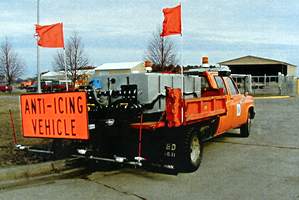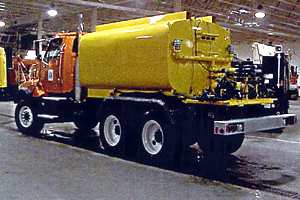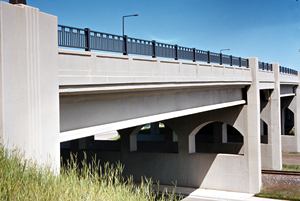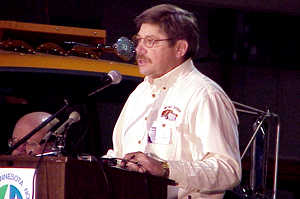 |
 |
|
 |
Anti-icing chemicals give plow jockeys leg up on winter storms |
 |
 |
 |
This anti-icing unit mounted on a pick-up chassis will dispense anti-icing
materials on Willmar bridges and highways. Staff photo
|
This winter as Mn/DOT snowplow operators shoot out of truck stations from Baudette
to Winona, they’ll carry something new in their saddlebags—anti-icing chemicals
to keep snow and ice from sticking to the road.
Anti-icing employs applying liquid chemicals to the roadway before a storm
occurs to prevent ice and snow from bonding with the pavement surface. Conventional
de-icing uses salt and/or liquid chemicals to melt snow and ice following a
storm.
Although anti-icing is newer in some places than in others, it’s already neck-and-neck
with traditional de-icing practices in the race to clear ice and snow from the
state’s highways as quickly as possible. Mn/DOT’s first experiment with anti-icing
occurred in the mid-1990s.
Since then, maintenance managers and researchers, supervisors and workers have
refined equipment, techniques and materials to enable anti-icing to evolve into
a standard winter practice.
This winter, crews throughout the department will place these chemicals on
bridge decks and other locations before icing conditions occur. Expanding the
use of anti-icing should make roads as safe as possible for the state’s motorists.
Cowboys
We are the Mn/DOT cowboys.
On steel broncos we all ride;
Our event course is the pavement,
The wing is by our side.
The gas pedal is our silver spur,
That makes our steel horse go;
We hammer down, right past town,
A most impressive show!
Our hands are on the steering wheel,
The reins for our steel horse;
The centerline's our pattern,
To follow an even course.
The guardrails are our barrels,
Around them all we go;
Scraping off the ice,
Plowing off the snow.
Our time clock is the public,
A clear trail we will provide,
To give the traveling public,
A safe, uneventful ride.
Wendy Frederickson
Maintenance supervisor, Virginia
|
"We’ve been doing anti-icing up here for about six years," said Tim
Sheehy, maintenance superintendent at Virginia. "We have two single-axle
trucks equipped with 1,200-gallon tanks and five smaller, 200-gallon units mounted
on pickup chassis. We know it really works when we get the equipment out there."
Sheehy said anti-icing could reduce the use of salt and other granular chemicals
by as much as one-third. This cuts costs, reduces the need to repeat route coverage,
and decreases chemical runoff into the environment. Virginia typically uses
magnesium chloride mixed with a corrosion inhibitor for anti-icing.
Metro maintenance superintendent Norm Ashfeld said the division will use anti-icing
again this winter on bridge decks, the HOV lane on I-394 and other spots prone
to early freezing.
"As we get into the latter part of November and December, we’ll start
anti-icing on many of our problem bridges such as the flyover ramps at the Mall
of America in Bloomington," he said. "Anti-icing really works well
to prevent frost."
Other areas using it this year include St. Cloud and Willmar. Randy Reznicek,
maintenance superintendent at St. Cloud, is expanding anti-icing on low-volume
roads, shady spots and bridge decks.
At Willmar, maintenance supervisor Dennis Marty is gearing up to start anti-icing
on the highways that converge on the city of Willmar. The Willmar District,
he said, will equip nine more trucks with anti-icing gear in the future.
"We’ve got a 400-gallon tank mounted on a pick-up that we’re going to
use on Hwy 23 and Hwy 71 and about a dozen bridges in the Willmar area,"
he said.
Marty said this unit uses ground-oriented radar to measure conditions and determine
the most effective dosage of anti-icing chemicals.
The steady spread of anti-icing use indicates its value and growing acceptance,
according to Bob Vasek, maintenance operations support engineer, Maintenance.
His office is developing guides for operators and developing specifications
for anti-chemicals to conform to those used by neighboring states.
 |
Metro’s specially equipped anti-icing truck is ready to apply chemicals
to bridges, ramps and other frost-prone areas. Staff photo
|
Vasek added that Mn/DOT is also developing equipment such as "slide-in"
anti-icing units that can easily be mounted on different truck bodies. Mn/DOT
may also eventually specify that snowplows come factory-equipped to use both
liquid and granular chemicals.
"Anti-icing allows us to save on de-icing chemicals such as salt and mechanical
removal such as plowing and blading," he added. "It will help us avoid
situations such as the Halloween Blizzard of 1991 when a strong ice to pavement
bond caused major problems."
By Craig Wilkins
|
back

|
 |
Both visible and ‘hidden’ disabilities can affect the workplace, panel says |
 |
 |
The Management Operations Group/Program Support Group/ Modal Operations Division
Diversity Committee held a panel discussion recently to explore how disabilities
can affect the workplace.
Panelists included Beverly Kelley, Americans with Disabilities Act case manager,
Human Resources; Pat Krinke, transcriptionist; Administrative Services; Robert
Bury, fabricator, Bridges & Structures; Justina Dansky, staffing specialist;
and Human Resources and Erling Hallanger, an engineering specialist with Business
Planning.
Marlene Schoenberg, a speech and language pathologist, led the discussion.
Schoenberg is also president of Ethnic Communication Arts, a multicultural speech,
language and diversity firm. Schoenberg talked about how easily communications
breakdowns can occur between individuals with and without disabilities.
"Sometimes individuals without disabilities hide behind the mask of fear,
afraid of saying the wrong thing, afraid they’re going to hurt someone,"
she said.
To make these interactions, easier Schoenberg suggested using a multi-faceted
approach to communicating.
"According to people’s different disabilities, there are different approaches
to help them," she said.
Robert Bury, who is deaf, is a native of New Zealand and learned American Sign
Language from his spouse. He said that he communicates best with hearing people
through writing rather than reading lips. He also said that he is sensitive
to hearing-enabled individuals who complain that he is too loud while communicating.
He is unable to gauge the level of noise around him.
Pat Krinke has worked for Mn/DOT 40 years and has been blind for 37 years.
Krinke has enjoyed Mn/DOT, she said, adding that the department has supported
accommodations that enable her to work. Her only frustration, she added, is
being unable to see people as she walks around.
"When I walk down the hallway, I know you’re there," she said. "I
don’t know if you’re smiling back at me; I don’t know if you’re frowning at
me. I don’t know if you’re ignoring me. For me, that’s a problem because I love
interacting with people. But that’s my problem, not yours."
Krinke added that she welcomes a pat on the arm, or a hug.
Dansky has Type 1 diabetes, a "hidden" disability. She encourages
individuals to ask her questions about her illness.
"I want people to be comfortable," she said. "I don’t want
anyone to treat me any differently, but there are times when I may need assistance.
That’s only in cases of low blood sugar. Anytime you have questions, ask away.
I want people to be comfortable and I want to be comfortable."
Erling Hallanger, who has worked for Mn/DOT 33 years, contracted rheumatic
fever as a child. This in turn led to severe rheumatoid arthritis. In his youth,
Hallanger said he dealt with low self-esteem, but he realized he was a child
of God and equal to others. He has arthritis in his knees, hips, legs, joints
and spine.
"I don’t think of myself as being handicapped until I look in the mirror,"
Hallanger said. "I don’t like being pitied. Just because I have a physical
handicap, doesn’t mean I don’t have a good mind. I can still do many physical
things, so I am not totally handicapped physically. Please treat me like a normal
person."
Kelley spoke about her experience as a caretaker and advocate for individuals
with disabilities. Kelley has two children with disabilities. She fought for
support in the workplace as a working mother and in the education system for
her children. She said that being a caretaker could be positive or negative.
"It depends on how people accept you and the person with the disability,"
she said. However, legislation such as the Family Medical Leave Act and ADA
accommodations make life easier for Kelley and her children, she said.
Schoenberg gave some tips for individuals with and without disabilities on
how to communicate more comfortably.
"Be patient," she advised. "Look beyond disability. Use the
multi-faceted approach; use active listening; avoid pity and embarrassment.
Speak more slowly, repeat calmly and use acts of kindness."
By Maya Beecham
|
back

|
 |
FHWA recognizes design excellence in Minnesota projects |
 |
 |
 |
The design for a new Hwy 33 bridge in Cloquet earned honors for retaining
design features from the obsolete bridge it replaced. Photo by Neil
Kveberg
|
Minnesota won eight "Excellence in Highway Design" awards in the biennial competition
sponsored by the Federal Highway Administration.
Mn/DOT chalked up awards for six trunk highway projects and also helped Hennepin
and Ramsey counties with their own successful state aid highway project submissions.
Gray’s Bay Bridge on Hennepin County Hwy 101 in Wayzata and Minnetonka garnered
the county an Excellence Award for major highway structures that cost less than
$10 million. This project, as well as the others, applied context sensitive
design principles to create mobility and safety improvements that met the needs
of users, neighboring communities and the environment.
Minnesota earned merit awards for following projects:
-
Silver Creek Cliff Tunnel and North Shore Scenic Highway
-
Trunk Highway 371 Bridge over Mississippi River in Brainerd
-
County State Aid Highway 96 reconstruction in Ramsey County
Honorable mention awards include:
-
Hwy 61 reconstruction through Schroeder
-
Hwy 33 over the St. Louis River in Cloquet
-
Hwy 55 and its adjacent Longfellow House and Minnehaha Park land bridge
in Minneapolis
-
Hwy 61 Gooseberry River Crossing near Two Harbors
 |
Moving this historic Longfellow House away from Hwy 55 and closer to
Minnehaha Park earned honors for Mn/DOT and the Minneapolis Park
Board. Photo by Neil Kveberg
|
Minnesota submitted a total of 19 projects and won more awards than any other
state. Since 1973, Minnesota has won 42 FHWA awards in the biennial Excellence
in Highway Design Awards Program, said Scott Bradley, principal landscape architect,
Office of Technical Support.
"These awards further our credibility, accountability and trust in alliance
with our external stakeholders and the public," he said. " They demonstrate
excellence in design and development of transportation facilities that satisfy
public needs while leaving a positive public works legacy."
Award categories include urban highways, rural highways, major highway structures,
historic preservation, intelligent transportation systems and intermodal transportation
facilities.
Each category allocates one excellence award winner and one or more merit and
honorable mention awards. Since 1968, FHWA has showcased hundreds of outstanding
examples of highways, bridges, pedestrian facilities, roadside facilities and
other facets of roadway design through its awards program.
By Sue Stein
|
back

|
 |
Metro Division turns the color purple into snowfighting ally |
 |
 |
 |
Norm Ashfeld, Metro maintenance superintendent, talked about de-icing
techniques.. Photo by Mark Fischbach
|
Purple will become the color of the day and of this winter season for some
Twin Cities Metro area residents and visitors when the snow and ice arrive in
earnest within the next few days (or weeks). That's when the public will begin
to see maintenance trucks spraying purple salt onto icy, snow-covered highways
in the Lakeville area.
Twin Cities area reporters got their first look on Nov. 12 at what could become
a most welcome color for many drivers. That's when Mn/DOT's Metro Division unsheathed
its snow-fighting arsenal to the news media, an arsenal which will include Metro's
first use of purple-colored salt. The salt containing a purple dye will be tested
in the Lakeville area first.
This darker colored salt will absorb heat from the sun to speed the melting
process. It will also help snowplow operators to see where they have already
placed salt when they make repeated passes on the same section of highway. In
addition, Maintenance crews will pre-wet the with anti-icing chemicals to increase
its effectiveness.
Purple emerged as the clear favorite color in polling at Mn/DOT’s exhibit at
the 2002 Minnesota State Fair.
The open house at the Cedar Avenue Truck Station acquainted news reporters
with Mn/DOT’s array of snowfighting weapons and warriors. These include an on-call
meteorologist, anti-icing equipment (see related Newsline story) and more than
500 trained snowplow operators ready to take on winter.
Officials from the Minnesota State Patrol, who also participated in the open
house, advised motorists to travel only when they must, allow extra time when
it snows and to give snowplow operators the room they need to work.
By Craig Wilkins
|
back

|
 |
Mn/DOT promotes safety during Dakota march |
 |
 |
A commemorative march by Dakota people along Hwys 13, 15 and 169 occurred without
incident, thanks in part to support by Mn/DOT district and Metro Division staff.
The march to honor the memory of the forced removal of Dakota people in 1862
during the Dakota war started in Morgan on Nov. 7 and ended Nov. 13 at Fort
Snelling.
The march included people on foot and riding on horseback and in wagons along
the highways’ shoulder. The march route included Sleepy Eye, New Ulm, Mankato,
St. Peter, Jordan and Prior Lake.
"Throughout the march, Mn/DOT partnered with the State Patrol to monitor
their progress," said Brian Kamnikar, Metro Traffic Engineering. "Several
participants had cell phones and kept in contact with the Patrol and Mn/DOT."
Kamnikar and district traffic staff helped the marchers plan a route that would
avoid construction sites and be safe for pedestrians and riders. They also suggested
that the marchers wear reflective clothing, use a trailing vehicle with flashing
amber lights and adjust their marching hours to avoid peak periods of traffic.
About 30 marchers started on Nov. 7, but the march’s ranks were expected reach
more than 100 by the time it entered Fort Snelling on Nov. 13.
By Shayla Cain
|
back

|
 |
Work zone safety message carries the day at Gophers vs. Michigan |
 |
 |
If the University of Minnesota’s Gopher football team had
followed the advice –Stay Back Stay Alive—printed on the thousands of windshield
scrapers handed out at Saturday ‘s game with Michigan, they might have saved
themselves a humbling defeat.
The game, however, went on. So, too, did Mn/DOT’s efforts
to inform the fans at the Metrodome in Minneapolis to use extra caution when
driving this winter.
People who attended the game also had an opportunity to
check out a fully equipped Mn/DOT snowplow, talk with Metro Division plow operators
and visit an information booth staffed by Metro Division and Central Office
communicators.
The promotional event at the Metrodome helps begin Mn/DOT’s
winter-long effort to emphasize drivers’ obligations to give snowplow operators
the space they require while making the state’s highways passable and safe.
Kevin Walker, Metro, said the event is also part of the
statewide observance of Winter Safety Awareness Week.
"It was a good event," he said. "The fans were receptive
and I believe they took away the awareness of their responsibility for work
zone safety this winter."
By Craig Wilkins
|
back

|
 |
|
 |



